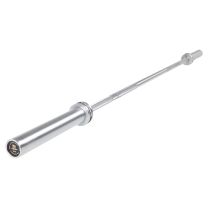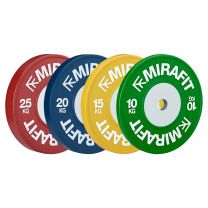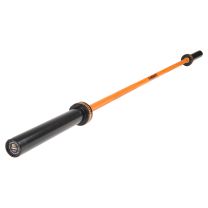Are Women's Barbells Just For Women?
Are Women's Barbells Just For Women?

It seems pretty odd to think of a time when women weren’t lifting weights doesn’t it? Well, it was only at the 2000 Sydney Olympics when women’s Olympic Weightlifting was added as an Olympic event.
Thankfully we’ve progressed a lot further since then, and it is far from uncommon to see women participating in weightlifting sports.
As a result of women being included in the sport, Women's Barbells were introduced, featuring a different specification, set by the IWF (International Weightlifting Federation).
Now, most gyms cater to all with both men’s and women’s barbells available to use. But what’s the difference? And why should you consider using a women’s barbell?
What is the Difference Between Men's and Women's Barbells?

There are four main aspects that differ between a women’s and a men’s barbell, they categorise as weight, length, sleeve length and shaft diameter. All of these features are covered as part of the IWF rule book so that the same specification bar is always used in competitions.
Weight - Traditionally an Olympic barbell weighs 20kg, whereas a women’s bar weighs 15kg.
Length - A women’s barbell is 6.6ft and a man’s barbell is 7.2ft.
Sleeve length - This is the end of the barbell that you add the plates to. A women’s barbell is 12.6 inches in length and a man’s is 16.4 inches.
Shaft diameter - The shaft diameter is the width of the bar. A traditional barbell is 28mm in diameter and a women’s barbell is 25mm.
Who Can Use a Women's Barbell?

The term ‘women’s barbell’ can be quite misleading because anyone can use one. In fact, a lot of the time they are simply called 15kg Olympic barbells.
Women’s barbells have some advantages for everyone depending on your training goals. One of the biggest benefits of using a women’s barbell is that it is smaller and therefore more accessible for beginners or those that need to begin with a lighter weight.
If you want to practise movements such as Olympic lifts, barbell squats and deadlifts, you are restricted to only being able to begin with 20kg if you use a traditional barbell. This might be too heavy for some people and so a women’s barbell gives the advantage of being able to start lighter.
Likewise, with the length of the women’s barbell being shorter, this makes it more convenient if you’re training in a smaller and more compact space such as home gyms where you might not have much space available. Despite being a shorter total length, the centre section of the women’s bar is the same length as a 20kg barbell so can still be used with power racks and squat racks.
One possible downside to using a women’s barbell is that you can’t add quite as many weight plates to the bar due to the sleeves being shorter. This may become an issue if you are lifting very heavy weights, depending on which plates are being used. However, there are several ways you can make the workout more difficult without adding more weight.
• Increase the repetitions
• Increase the number of sets
• Slow down the tempo
• Add a pause to the movement
You can also use different weight plates because some plates, such as our Competition Bumper Plates, have a thinner profile which allows more weight to fit onto the same sleeve length.
Should Women Only Use a Women's Barbell?

Absolutely not. No one should be restricted to using any kind of barbell. It is just that the women’s barbell has been designed with the female anatomy in mind and has been built to improve performance in female athletes.
The smaller shaft diameter was designed as women typically have smaller hands than men. This makes it easier for women to grip the bar if it has a smaller diameter. Likewise, the shorter length lines up with the fact that on average, men’s shoulders are wider than women’s.
These are all small adjustments to help improve performance for women in competition. That being said, you can use any barbell in training and it is only in IWF competitions that the specific rules on bars must be followed.
There are hundreds of variations of Barbells out there to cater for different movements. Separating an Olympic barbell between men’s and women’s might seem to make things more complicated, but they have been designed purely to improve performance in both sexes. If you are a competitive athlete then practicing with the correct bar in training will be key but for regular lifters, the most important thing to remember is that anyone can use either barbell, it’s all down to personal preference.
Written by guest author Eryn Barber.
For more content, follow us on Instagram, YouTube, TikTok, and on our official Mirafit Facebook page.
Enter your email to signup to our newsletter
Tags: Exercise Type > Strength







